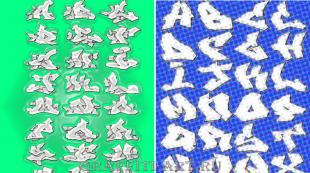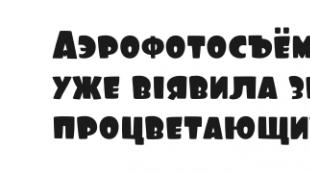Complete dissociation. The theory of electrical dissociation. Electrolytic dissociation degree
All substances, according to their ability to conduct electric current in solution or in a molten state, can be divided into two groups: electrolytes and non-electrolytes.
Electrolytes substances are called, solutions or melts of which conduct an electric current. Electrolytes include acids, bases, and salts.
Non-electrolytes substances are called, solutions or melts of which do not conduct electric current. For example, many organic substances.
The ability of electrolytes (conductors of the second kind) to conduct electric current is fundamentally different from the electrical conductivity of metals (conductors of the first kind): the electrical conductivity of metals is due to the movement of electrons, and the electrical conductivity of electrolytes is associated with the movement of ions.
It was found that in solutions of acids, bases and salts, the experimentally found values of p, tcryst., Tboil., Posm, are higher than those theoretically calculated for the same solution by its molar concentration in i once ( i- isotonic coefficient). Moreover, the number of particles in the NaCl solution increased almost 2 times, and in the CaCl2 solution - 3 times.
To explain the features of the behavior of electrolytes, the Swedish scientist S. Arrhenius in 1887 proposed a theory called electrolytic dissociation theory... The essence of the theory is as follows:
- 1. When dissolved in water, electrolytes decompose (dissociate) into charged particles (ions) - positively charged cations (Na +, K +, Ca2 +, H +) and negatively charged anions (Cl-, SO42-, CO32-, OH-). The properties of ions are completely different from those of the atoms that formed them. The decomposition of a neutral substance into ions as a result of chemical interaction with a solvent is called electrolytic dissociation.
- 2. Under the action of an electric current, ions acquire a directional movement: cations move to a negatively charged electrode (cathode), anions - to a positively charged electrode (anode).
- 3. Dissociation is a reversible and equilibrium process. This means that in parallel with the disintegration of molecules into ions (dissociation), the process of combining ions into molecules (association) is going on: CA K + + A-.
- 4. In solution, ions are in a hydrated state.
For a quantitative assessment of electrolytic dissociation, the concept is used degree of electrolytic dissociation() is the ratio of the number of molecules decomposed into ions to the total number of dissolved molecules. The degree of dissociation is determined empirically and is expressed in fractions or percentages. The degree of electrolytic dissociation depends on the nature of the solvent and the solute, the temperature and concentration of the solution:
- 1. The more polar the solvent, the higher the degree of dissociation of the electrolyte in it.
- 2. Substances with ionic and covalent polar bonds undergo dissociation.
- 3. The rise in temperature, increases the dissociation of weak electrolytes.
- 4. With a decrease in the concentration of the electrolyte (with dilution), the degree of dissociation increases.
Depending on the magnitude of the degree of dissociation, electrolytes (at a concentration of their solutions of 0.1 M) are conventionally divided into:
According to the type of ions formed during dissociation, all electrolytes can be divided into acids, bases, and salts.
Acid- electrolytes dissociating with the formation of only H + cations and an acid residue (Cl- - chloride, NO3- - nitrate, SO42- - sulfate, HCO3 bicarbonate, CO32 carbonate). For example: НСl Н ++ Сl-, H2SO4 2Н ++ SO42-.
The presence in acid solutions of a hydrogen ion, more precisely, a hydrated H3O + ion, determines the general properties of acids (sour taste, effect on indicators, interaction with alkalis, interaction with metals with the release of hydrogen, etc.).
In polybasic acids, dissociation occurs stepwise, and each step is characterized by its own magnitude of the degree of dissociation. So, phosphoric acid dissociates in three steps:
|
Stage I |
H3РO4 Н + + H2РO4- |
|
|
II stage |
H2РO4- Н + + HРO42- |
|
|
III stage |
HPO42- H + + PO43- |
And 3<2<1, т.е. распад электролита на ионы протекает, в основном, по первой ступени и в растворе ортофосфорной кислоты будут находиться преимущественно ионы Н+ и H2РO4-. Причины этого в том, что ионы водорода значительно сильнее притягиваются к трехзарядному иону РO43- и двухзарядному иону HРO42-, чем к однозарядному H2РO4-. Кроме того, на 2-ой и 3-ей ступенях имеет место смещение равновесия в сторону исходной формы по принципу Ле-Шателье за счет накапливающихся ионов водорода.
Foundations- electrolytes dissociating to form only hydroxide ions (OH-) as anions. After removal of OH-, cations remain: Na +, Ca2 +, NH4 +. For example: NaOH Na + + OH-, Ca (OH) 2 Ca2 + + 2 OH-.
The general properties of bases (soapiness to the touch, action on the indicator, interaction with acids, etc.) are determined by the presence of OH- hydroxo group in the base solutions.
For multi-acid bases, stepwise dissociation is characteristic:
|
Stage I |
Ва (ОН) 2 Ва (ОН) + + ОН- |
|
II stage |
Ba (OH) + Ba2 + + OH- |
Dissociation of amphoteric hydroxides proceeds both as a base and as an acid. So, the dissociation of zinc hydroxide can proceed in the following directions (in this case, the equilibrium shifts depending on the medium according to the Le Chatelier principle):
Salt- these are electrolytes dissociating into metal cations (or groups replacing it) and anions of the acid residue.
Medium salts dissociate completely: CuSO4 Cu2 + + SO42-. Unlike medium salts, acidic and basic salts dissociate in steps:
|
Stage I |
NaHCO3 Na + + HCO3- |
Сu (ОН) Cl Сu (ОН) + + Cl- |
|
II stage |
НСО3- Н + + СО32- |
Cu (OH) + Cu2 + + OH-, |
moreover, the degree of dissociation of salts in the second stage is very small.
Exchange reactions in electrolyte solutions are reactions between ions. A necessary condition for the course of exchange reactions in electrolyte solutions is the formation of weakly dissociating compounds or compounds that are released from the solution in the form of a precipitate or gas.
When writing the equations of reactions in ionic-molecular form, weakly dissociating, gaseous and sparingly soluble compounds are written in the form molecules, and soluble strong electrolytes - in the form ions. When writing ionic equations, be sure to follow the table of solubility of acids, bases and salts in water (Appendix A).
Let's consider the method of writing ionic equations using examples.
Example 1. Write the reaction equation in ionic-molecular form:
ВаСl2 + K2SО4 = ВаSО4 + 2KСl
Solution: Salts are strong electrolytes and almost completely dissociate into ions. Since BaSO4 is a practically insoluble compound (see the table in Appendix A), the bulk of barium sulfate will be in an undissociated form, therefore we will write this substance in the form of molecules, and the rest of the salts, which are soluble, in the form of ions:
Ba2 + + 2Сl- + 2K + + SO42- = BaSО4 + 2K + + 2Сl-
As can be seen from the obtained complete ionic-molecular equation, ions K + and Сl- do not interact, therefore, excluding them, we obtain a short ionic-molecular equation:
Ba2 + + SO42- = BaSO4,
The arrow indicates that the resulting substance is precipitated.
Any reactions occurring in solutions between electrolytes can be represented by ionic equations. Moreover, the essence of any chemical reaction is reflected precisely by a short ionic-molecular equation. Based on the ionic-molecular equation, you can easily write the molecular one.
Example 2. Match the molecular equation to the following ionic molecular equation: 2H + + S2- = H2S.
Solution: Hydrogen ions are formed by the dissociation of any strong acid, such as HCl. To the hydrogen ions in the short ionic equation, two chlorine ions must be added. Cations (for example, 2K +) should be added to sulfide ions, forming a soluble, well dissociating electrolyte. Then the same ions must be written on the right side. Then the complete ionic-molecular and molecular equations will have the form:
- 2Н + + 2Сl- + 2K + + S2- = Н2S + 2K + + 2Сl-
- 2 НСl + K2S = Н2S + 2 KСl-
Themes of the USE codifier:Electrolytic dissociation of electrolytes in injection solutions. Strong and weak electrolytes.
– these are substances, solutions and melts of which conduct an electric current.
Electric current is the ordered movement of charged particles under the influence of an electric field. Thus, there are charged particles in solutions or molten electrolytes. In electrolyte solutions, as a rule, electrical conductivity is due to the presence of ions.
Jonah Are charged particles (atoms or groups of atoms). Separate positively charged ions ( cations) and negatively charged ions ( anions).
Electrolytic dissociation - This is the process of decomposition of the electrolyte into ions during its dissolution or melting.
Separate substances - electrolytes and non-electrolytes... TO non-electrolytes include substances with a strong covalent non-polar bond (simple substances), all oxides (which are chemically not interact with water), most organic substances (except for polar compounds - carboxylic acids, their salts, phenols) - aldehydes, ketones, hydrocarbons, carbohydrates.
TO electrolytes include some substances with a covalent polar bond and substances with an ionic crystal lattice.
What is the essence of the electrolytic dissociation process?
Place some sodium chloride crystals in a test tube and add water. After a while, the crystals will dissolve. What happened?
Sodium chloride is a substance with an ionic crystal lattice. NaCl crystal consists of Na + ions and Cl - ... In water, this crystal breaks down into structural units, ions. In this case, ionic chemical bonds and some hydrogen bonds between water molecules disintegrate. The Na + and Cl - ions trapped in the water interact with water molecules. In the case of chloride ions, we can talk about the electrostatic attraction of dipole (polar) water molecules to the chlorine anion, and in the case of sodium cations, it approaches donor-acceptor in nature (when the electron pair of the oxygen atom is placed on the vacant orbitals of the sodium ion). Ions surrounded by water molecules are coveredhydration shell.
Dissociation of sodium chloride is described by the equation:
NaCl = Na + + Cl -
When compounds with a covalent polar bond are dissolved in water, water molecules, surrounding a polar molecule, first stretch the bond in it, increasing its polarity, then break it into ions, which are hydrated and evenly distributed in the solution. For example, hydrochloric xylote dissociates into ions as follows: HCl = H + + Cl -.

During melting, when the crystal is heated, the ions begin to perform intense vibrations in the nodes of the crystal lattice, as a result of which it is destroyed, a melt is formed, which consists of ions.
The process of electrolytic dissociation is characterized by the magnitude of the degree of dissociation of molecules of a substance:
Dissociation degree Is the ratio of the number of dissociated (disintegrated) molecules to the total number of electrolyte molecules. That is, what fraction of the molecules of the initial substance decomposes into ions in solution or melt.
α = N prodiss / N ref, where:
N prodiss is the number of dissociated molecules,
N ref is the initial number of molecules.
According to the degree of dissociation, electrolytes are divided by divided by strong and weak.
Strong electrolytes (α≈1):
1. All soluble salts (including salts of organic acids - potassium acetate CH 3 COOK, sodium formate HCOONa, etc.)
2. Strong acids: HCl, HI, HBr, HNO 3, H 2 SO 4 (in the first stage), HClO 4, etc.;
3. Alkalis: NaOH, KOH, LiOH, RbOH, CsOH; Ca (OH) 2, Sr (OH) 2, Ba (OH) 2.
Strong electrolytes decompose into ions almost completely in aqueous solutions, but only in. In solutions, even strong electrolytes can only partially decompose. Those. the degree of dissociation of strong electrolytes α is approximately equal to 1 only for unsaturated solutions of substances. In saturated or concentrated solutions, the degree of dissociation of strong electrolytes can be less than or equal to 1: α≤1.
Weak electrolytes (α<1):
1. Weak acids, incl. organic;
2. Insoluble bases and ammonium hydroxide NH 4 OH;
3. Insoluble and some slightly soluble salts (depending on solubility).
Non-electrolytes:
1. Oxides that do not interact with water (oxides interacting with water, when dissolved in water, enter into a chemical reaction with the formation of hydroxides);
2. Simple substances;
3. Most organic substances with weakly polar or non-polar bonds (aldehydes, ketones, hydrocarbons, etc.).

How do substances dissociate? The degree of dissociation is distinguished strong and weak electrolytes.
Strong electrolytes dissociate completely (in saturated solutions), in one step, all molecules disintegrate into ions, almost irreversibly. Please note that only stable ions are formed in solution during dissociation. The most common ions can be found in the solubility table - this is your official cheat sheet for any exam. The degree of dissociation of strong electrolytes is approximately equal to 1. For example, during the dissociation of sodium phosphate ions Na + and PO 4 3– are formed:
Na 3 PO 4 → 3Na + + PO 4 3-
NH 4 Cr (SO 4) 2 → NH 4 + + Cr 3+ + 2SO 4 2–
Dissociation weak electrolytes : polybasic acids and polyacid bases occurs stepwise and reversibly... Those. during the dissociation of weak electrolytes, only a very small part of the initial particles decomposes into ions. For example, carbonic acid:
H 2 CO 3 ↔ H + + HCO 3 -
HCO 3 - ↔ H + + CO 3 2–
Magnesium hydroxide also dissociates in 2 stages:
Mg (OH) 2 ⇄ Mg (OH) + OH -
Mg (OH) + ⇄ Mg 2+ + OH -
Acid salts also dissociate stepwise, first the ionic bonds are broken, then the covalent polar ones. For example, potassium hydrogen carbonate and magnesium hydroxychloride:
KHCO 3 ⇄ K + + HCO 3 - (α = 1)
HCO 3 - ⇄ H + + CO 3 2– (α< 1)
Mg (OH) Cl ⇄ MgOH + + Cl - (α = 1)
MgOH + ⇄ Mg 2+ + OH - (α<< 1)
The degree of dissociation of weak electrolytes is much less than 1: α<<1.
The main provisions of the theory of electrolytic dissociation, thus:
1. When dissolved in water, electrolytes dissociate (decompose) into ions.
2. The reason for the dissociation of electrolytes in water is its hydration, i.e. interaction with water molecules and breaking the chemical bond in it.
3. Under the influence of an external electric field, positively charged ions move to a positively charged electrode - the cathode, they are called cations. Negatively charged electrons move towards the negative electrode - the anode. They are called anions.
4. Electrolytic dissociation occurs reversibly for weak electrolytes, and almost irreversible for strong electrolytes.
5. Electrolytes can dissociate into ions to varying degrees, depending on external conditions, concentration and nature of the electrolyte.
6. The chemical properties of ions differ from those of simple substances. The chemical properties of electrolyte solutions are determined by the properties of those ions that are formed from it during dissociation.
Examples.
1. With incomplete dissociation of 1 mol of salt, the total amount of positive and negative ions in the solution was 3.4 mol. Salt formula - a) K 2 S b) Ba (ClO 3) 2 c) NH 4 NO 3 d) Fe (NO 3) 3
Solution: First, let's determine the strength of electrolytes. This can be easily done using the solubility table. All salts given in the answers are soluble, i.e. strong electrolytes. Next, we write down the equations of electrolytic dissociation and use the equation to determine the maximum number of ions in each solution:
a) K 2 S ⇄ 2K + + S 2–, with the complete disintegration of 1 mol of salt, 3 mol of ions are formed, more than 3 mol of ions will not work in any way;
b) Ba (ClO 3) 2 ⇄ Ba 2+ + 2ClO 3 -, again, when 1 mol of salt decays, 3 mol of ions are formed, more than 3 mol of ions are not formed in any way;
v) NH 4 NO 3 ⇄ NH 4 + + NO 3 -, during the decomposition of 1 mol of ammonium nitrate, 2 mol of ions are formed at most, more than 2 mol of ions are not formed in any way;
G) Fe (NO 3) 3 ⇄ Fe 3+ + 3NO 3 -, with the complete decomposition of 1 mol of iron (III) nitrate, 4 mol of ions are formed. Therefore, with incomplete decomposition of 1 mol of iron nitrate, the formation of a smaller number of ions is possible (incomplete decomposition is possible in a saturated salt solution). Therefore, option 4 suits us.
Aqueous solutions of some substances are conductors of electric current. These substances are classified as electrolytes. Electrolytes are acids, bases and salts, melts of certain substances.
DEFINITION
The process of decomposition of electrolytes into ions in aqueous solutions and melts under the action of an electric current is called electrolytic dissociation.
Solutions of some substances in water do not conduct electricity. Such substances are called non-electrolytes. These include many organic compounds such as sugars and alcohols.
Electrolytic dissociation theory
The theory of electrolytic dissociation was formulated by the Swedish scientist S. Arrhenius (1887). The main provisions of the theory of S. Arrhenius:
- electrolytes, when dissolved in water, disintegrate (dissociate) into positively and negatively charged ions;
- under the action of an electric current, positively charged ions move to the cathode (cations), and negatively charged ones move to the anode (anions);
- dissociation is a reversible process
KA ↔ K + + A -
The mechanism of electrolytic dissociation is ion-dipole interaction between ions and dipoles of water (Fig. 1).
Rice. 1. Electrolytic dissociation of sodium chloride solution
Substances with ionic bonds dissociate most easily. Similarly, dissociation occurs in molecules formed by the type of polar covalent bond (the nature of the interaction is dipole-dipole).
Dissociation of acids, bases, salts
During the dissociation of acids, hydrogen ions (H +) are always formed, or rather, hydronium (H 3 O +), which are responsible for the properties of acids (sour taste, the action of indicators, interaction with bases, etc.).
HNO 3 ↔ H + + NO 3 -
During the dissociation of bases, hydrogen hydroxide ions (OH -) are always formed, which are responsible for the properties of the bases (change in the color of indicators, interaction with acids, etc.).
NaOH ↔ Na + + OH -
Salts are electrolytes, the dissociation of which produces metal cations (or ammonium cation NH 4 +) and anions of acid residues.
CaCl 2 ↔ Ca 2+ + 2Cl -
Polybasic acids and bases dissociate in steps.
H 2 SO 4 ↔ H + + HSO 4 - (I stage)
HSO 4 - ↔ H + + SO 4 2- (II stage)
Ca (OH) 2 ↔ + + OH - (I stage)
+ ↔ Ca 2+ + OH -
Dissociation degree
Among electrolytes, a distinction is made between weak and strong solutions. To characterize this measure, there is the concept and value of the degree of dissociation (). The degree of dissociation is the ratio of the number of molecules dissociated into ions to the total number of molecules. often expressed in%.
Weak electrolytes include substances in which in a decimolar solution (0.1 mol / l) the degree of dissociation is less than 3%. Strong electrolytes include substances in which the degree of dissociation is greater than 3% in a decimolar solution (0.1 mol / l). Solutions of strong electrolytes do not contain non-dissociated molecules, and the process of association (unification) leads to the formation of hydrated ions and ion pairs.
The degree of dissociation is particularly influenced by the nature of the solvent, the nature of the solute, the temperature (in strong electrolytes, the degree of dissociation decreases with increasing temperature, and in weak electrolytes it passes through a maximum in the temperature range of 60 o C), the concentration of solutions, the introduction of ions of the same name into the solution.
Amphoteric electrolytes
There are electrolytes that, when dissociated, form both H + and OH - ions. Such electrolytes are called amphoteric, for example: Be (OH) 2, Zn (OH) 2, Sn (OH) 2, Al (OH) 3, Cr (OH) 3, etc.
H + + RO - ↔ ROH ↔ R + + OH -
Ionic reaction equations
Reactions in aqueous solutions of electrolytes are reactions between ions - ionic reactions that are written using ionic equations in molecular, full ionic and abbreviated ionic forms. For instance:
BaCl 2 + Na 2 SO 4 = BaSO 4 ↓ + 2NaCl (molecular form)
Ba 2+ + 2 Cl − + 2 Na+ + SO 4 2- = BaSO 4 ↓ + 2 Na + + 2 Cl- (full ionic form)
Ba 2+ + SO 4 2- = BaSO 4 ↓ (abbreviated ionic form)
PH value
Water is a weak electrolyte, so the dissociation process is insignificant.
H 2 O ↔ H + + OH -
The law of mass action can be applied to any equilibrium and the expression for the equilibrium constant can be written:
K = /
The equilibrium concentration of water is a constant value, consequently.
K = = K W
It is convenient to express the acidity (basicity) of an aqueous solution in terms of the decimal logarithm of the molar concentration of hydrogen ions, taken with the opposite sign. This value is called the pH value.
All substances are divided into 2 large groups: electrolytes and non-electrolytes.
Electrolytes substances (excluding metals) are called, solutions or melts of which conduct an electric current. Electrolytes include compounds formed by ionic or covalent polar bonds. These are complex substances: salts, bases, acids, metal oxides (conduct electric current only in melts).
Non-electrolytes substances are called, solutions or melts of which do not conduct electric current. These include simple and complex substances formed by low-polarity or non-polar covalent bonds.
The properties of solutions and molten electrolytes were first explained at the end of the 19th century by the Swedish scientist Svante Arrhenius. He created a special electrolytic dissociation theory , the main provisions of which, revised and developed by other scientists, are currently formulated as follows.
1. Molecules (or formula units) of electrolytes in solutions or melts decompose into positively and negatively charged ions. This process is called electrolytic dissociation. The total sum of the charges of positive ions is equal to the sum of the charges of negative ions; therefore, solutions or melts of electrolytes as a whole remain electrically neutral. Ions can be like simple consisting of only one atom (Na +, Cu 2+, Cl -, S 2-), and complex consisting of atoms of several elements (SO 4 2–, PO 4 3–, NH 4 +, -).
Simple ions in their physical, chemical and physiological properties differ significantly from the neutral atoms from which they were formed. First of all, ions are much more stable particles than neutral atoms, and can exist in solutions or melts for an unlimited time without entering into irreversible interaction with the environment.
This difference in the properties of atoms and ions of the same element is explained by the different electronic structure of these particles.
So, simple ions of s- and p-elements are in a more stable state than neutral atoms, because they have a complete electronic configuration of the outer layer, for example:
The decomposition of electrolytes into ions in melts is carried out due to the action of high temperatures, and in solutions due to the action of solvent molecules.
A feature of ionic compounds is that there are ready-made ions in the nodes of their crystal lattice, and in the process of dissolution of such substances, the dipoles of the solvent (water) can only destroy this ionic lattice (Fig. 18).
Substances formed by polar covalent bonds pass into solution in the form of individual molecules, which, like Н 2 О molecules, are dipoles, for example:
 + –
+ –
In this case, the Н 2 О dipoles, orienting appropriately around the dissolved electrolyte molecule, cause further polarization of the covalent bond in it, and then its final heterolytic rupture (Fig. 29).

H – ClH + + Cl
Rice. 29. Scheme of electrolytic dissociation in a solution of a polar HCl molecule
The process of electrolytic dissociation proceeds simultaneously with the process of dissolution of substances, and therefore in solutions all ions are in a hydrated state (surrounded by shells of H2O molecules).
However, for simplicity, in the equations of chemical reactions, ions are depicted without the surrounding hydration shells: H +, NO 3 -, K +, etc.
2. Electrolyte ions in solution or melt due to thermal movement move randomly in all directions. But if electrodes are lowered into a solution or melt and an electric current is passed, then the positively charged ions of the electrolyte begin to move towards the negatively charged electrode - the cathode (therefore they are called differentlycations), and negatively charged ions - to a positively charged electrode - anode (therefore they are called differentlyanions).
Thus, electrolytes are second-class conductors. They carry an electric charge due to the directional movement of ions. Metals, on the other hand, are conductors of the first kind, because conduct an electric current due to the directional movement of electrons.
3. The process of electrolytic dissociation is reversible. Along with the decomposition of molecules into ions, the opposite process always occurs - the combination of ions into molecules or association. Therefore, in the equations of the reactions of electrolytic dissociation of substances, instead of the equal sign "=", they put the reversibility sign "", for example:
Substances-electrolytes, when dissolved in water, break down into charged particles - ions. The opposite is molarization, or association. The formation of ions is explained by the theory of electrolytic dissociation (Arrhenius, 1887). The mechanism of decomposition of chemical compounds during melting and dissolution is influenced by the characteristics of the types of chemical bonds, the structure and nature of the solvent.
Electrolytes and non-conductors
In solutions and melts, the destruction of crystal lattices and molecules occurs - electrolytic dissociation (ED). The disintegration of substances is accompanied by the formation of ions, the appearance of such a property as electrical conductivity. Not every compound is capable of dissociating, but only substances that initially consist of ions or strongly polar particles. The presence of free ions explains the ability of electrolytes to conduct current. Bases, salts, many inorganic and some organic acids have this ability. Non-conductors are composed of low-polarity or non-polarized molecules. They do not decompose into ions, being non-electrolytes (many organic compounds). Charge carriers are positive and negative ions (cations and anions).
The role of S. Arrhenius and other chemists in the study of dissociation
The theory of electrolytic dissociation was substantiated in 1887 by a scientist from Sweden S. Arrhenius. But the first extensive studies of the properties of solutions were carried out by the Russian scientist M. Lomonosov. Contributed to the study of charged particles arising from the dissolution of substances, T. Grothus and M. Faraday, R. Lenz. Arrhenius proved that many inorganic and some organic compounds are electrolytes. The Swedish scientist explained the electrical conductivity of solutions by the decomposition of matter into ions. Arrhenius' theory of electrolytic dissociation did not attach importance to the direct participation of water molecules in this process. Russian scientists Mendeleev, Kablukov, Konovalov and others believed that solvation occurs - the interaction of a solvent and a solute. When it comes to water systems, the name "hydration" is used. This is a complex physicochemical process, as evidenced by the formation of hydrates, thermal phenomena, a change in the color of the substance and the appearance of sediment.

The main provisions of the theory of electrolytic dissociation (TED)
Many scientists have worked to refine the theory of S. Arrhenius. It required its improvement, taking into account modern data on the structure of the atom, chemical bonds. The main provisions of the TED, which differ from the classical theses of the late 19th century, are formulated:

The phenomena occurring must be taken into account when drawing up equations: apply a special sign of a reversible process, calculate negative and positive charges: they must coincide in total.
Mechanism of ED of ionic substances
The modern theory of electrolytic dissociation takes into account the structure of electrolyte and solvent substances. When dissolving, bonds between oppositely charged particles in ionic crystals are destroyed under the influence of polar water molecules. They literally "pull" ions from the bulk into the solution. The decomposition is accompanied by the formation of a solvate (in water - hydration) shell around the ions. In addition to water, ketones and lower alcohols have an increased dielectric constant. During the dissociation of sodium chloride into Na + and Cl - ions, an initial stage is recorded, which is accompanied by the orientation of the water dipoles relative to the surface ions in the crystal. In the final stage, hydrated ions are released and diffuse into the liquid.

The mechanism of ED of compounds with a covalent strongly polar bond
Solvent molecules affect the elements of the crystal structure of non-ionic substances. For example, the effect of water dipoles on hydrochloric acid leads to a change in the type of bond in the molecule from covalent polar to ionic. The substance dissociates, hydrated ions of hydrogen and chlorine enter the solution. This example proves the importance of those processes that occur between the particles of the solvent and the dissolved compound. It is this interaction that leads to the formation of electrolyte ions.

Theory of electrolytic dissociation and the main classes of inorganic compounds
In the light of the main provisions of TED, an acid can be called an electrolyte, during the decomposition of which only the proton H + can be detected from positive ions. The dissociation of the base is accompanied by the formation or release from the crystal lattice of only the OH - anion and the metal cation. A normal salt upon dissolution gives a positive metal ion and a negative one - an acid residue. The basic salt is distinguished by the presence of two types of anions: the OH group and the acid residue. In an acidic salt, only hydrogen and metal are present from cations.
The power of electrolytes
To characterize the state of a substance in a solution, a physical quantity is used - the degree of dissociation (α). Find its value from the ratio of the number of disintegrated molecules to their total number in the solution. The depth of dissociation is determined by different conditions. The dielectric parameters of the solvent and the structure of the dissolved compound are important. Usually, the degree of dissociation decreases with increasing concentration and increases with increasing temperature. Often, the degree of dissociation of a particular substance is expressed in fractions of a unit.

Electrolyte classification
The theory of electrolytic dissociation at the end of the 19th century did not contain provisions on the interaction of ions in solution. The influence of water molecules on the distribution of cations and anions seemed insignificant to Arrhenius. Arrhenius's ideas about strong and weak electrolytes were formal. Based on the classical provisions, you can get the value α = 0.75-0.95 for strong electrolytes. The experiments proved the irreversibility of their dissociation (α → 1). Soluble salts, sulfuric and hydrochloric acids, alkalis are almost completely decomposed into ions. Sulfurous, nitrous, hydrofluoric, orthophosphoric acids are partially dissociated. Silicon, acetic, hydrogen sulfide and carbonic acids, ammonium hydroxide, and insoluble bases are considered weak electrolytes. Water is also referred to as a weak electrolyte. A small part of the Н 2 О molecules dissociates, while the molarization of the ions occurs.









